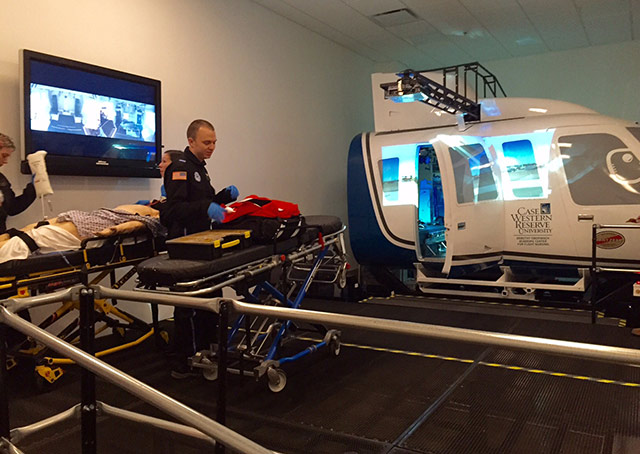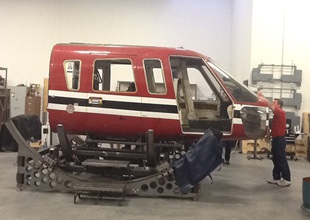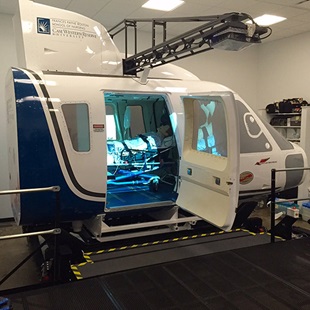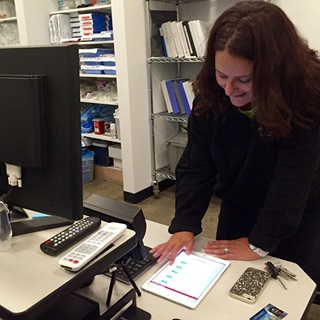Old bird gets new life in flight nurse program
Redbird helicopter sim trains flight nurses

A 1973 Sikorsky S-76 oil rig helicopter destroyed in hurricane Katrina is back at work, this time on a life-saving mission. But while most emergency services helicopters live a stress-filled, harried life, this one is patient and unassuming. You see, it never leaves the room, yet it can take students virtually anywhere in its new role as a simulator for flight nurse students at Case Western Reserve University in Cleveland.
The S-76 was plucked from the muck after the devastating 2005 hurricane and sent to a boneyard in Orlando, Florida, to be scrapped. Meanwhile, the administration at Case Western Reserve University was looking for a helicopter fuselage to use as a practice device for its students. However, when the Brown family out of Piqua, Ohio, owners of Hartzell Propeller, heard about the need, they thought it should go one step further. Why not add motion and projection and make it more realistic, asked Hartzell President Joe Brown. The Brown family has been a longtime supporter of the university.
Brown turned to his friend Jerry Gregoire, founder of Redbird Flight Simulations. Gregoire is a software engineer who loves a challenge. As it turns out, the prototype motion system for Redbird’s first helicopter simulator was in the factory and about to be scrapped. Perhaps it could be the foundation of a motion system for the nursing simulator.
Gregoire and Brown flew to Orlando to look at the S-76. “I took a piece of chalk and drew lines on the helicopter and told them to cut it here and here,” Gregoire said. “The guy says, ‘I can’t do that.’”

“But I don’t want the whole thing,” Gregoire retorted, and as usual, he won and soon just the fuselage and cockpit were on a truck headed to Redbird’s factory in Austin, Texas. “When we opened up the floorboards there was still water and mud from Katrina in the bottom,” Gregoire said.
With a lot of beefed-up structure, the repurposed motion system worked. Redbird staff installed a medevac interior in the fuselage and equipped it with multiple point-of-view cameras and other gear. “You should have seen a bunch of software guys trying to install a medevac interior,” Gregoire says with a laugh.
They did it, and everything in the interior works—the electrical outlets, medical monitors, patient oxygen system (although now it just puts out pressurized air), and the intercom system.
To add more realism, Gregoire designed a way to project a simulated environment through the fuselage windows. He at first planned to hang LED monitors on the outsides of the doors and other windows to be viewed by the students inside, but they turned out to be too heavy for the doors. So he replaced the windows with a fine white mesh pressed between layers of plastic. The mesh increases illumination projected on it. Projectors mounted on arms attached to the simulator project the simulated environment on the windows, giving those inside the sense of motion, which is enhanced by the motion of the simulator.
 A humongous speaker in the upper portion of the sim pumps out many decibels of realistic helicopter sounds and even provides some vibration, as you might experience in the real aircraft.
A humongous speaker in the upper portion of the sim pumps out many decibels of realistic helicopter sounds and even provides some vibration, as you might experience in the real aircraft.
The first-of-its-kind simulator provides a very realistic environment in which to train flight nurses, explained Stephanie Steiner, the director and an instructor in the university’s Dorothy Ebersbach Academic Center for Flight Nursing. The center is named for a Case Western Reserve University alumna who was a nurse and a Women Airforce Service Pilot during World War II. Flight nursing is a subspecialty in the graduate-level acute care nurse practitioner program in the Frances Payne Bolton School of Nursing. The subspecialty includes four classes and about 24 hours in the simulator, according to Steiner, who also is an active flight nurse at the Cleveland Clinic flying in an S-76. She and others in the program rewrote the course’s curriculum to incorporate the simulator. During classes, students are presented with a situation, either in a simulated emergency room environment where a patient needs a transfer to another facility, or at an accident scene. The simulation includes flight time in the sim to get to the scene and to move between points in real time, adding to the stress and reality of the situation. Most of the scenarios used at Case Western Reserve University are in the Cleveland area, but they could be anywhere given the Redbird flight simulation software’s realistic visual system.

The “patient” is SimMan, a $100,000 simulated patient that can be controlled wirelessly by an instructor outside the sim. SimMan emits vital signs and sounds, and even has a surface that simulates human skin. The students must diagnose his injuries, stabilize him with drugs and IVs, and move him into and out of the sim on a gurney, just as they would at an actual emergency scene. If they misdiagnose, the instructor can cause SimMan to respond the way a real person might, perhaps inducing a heart attack while in flight to the hospital. Then students must learn to react within the confines of the fuselage and communicate in the noise environment.
Meanwhile, the instructor also can introduce realistic ambient changes, such as nightfall, changing weather, and turbulence. In the future, the nursing school plans to incorporate aircraft failures, such as the need to make an off-airport emergency landing as a result of an engine chip light.
The simulator took about a year to develop and cost some $600,000, funded by Redbird and Hartzell. Steiner said numerous other EMS operators have already inquired about using the simulator, which the school is considering.



